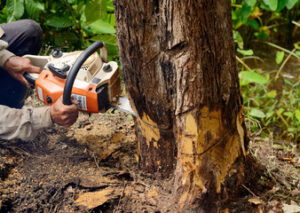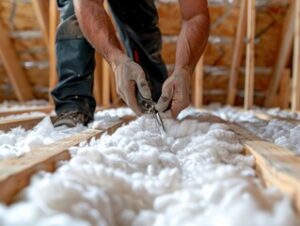Tree Removal Bryan TX is a meticulous operation that requires expertise, precision, and safety measures. It can cause serious damage to property if it falls on cars, homes, or power lines.

If you’re looking for a reliable service provider, ask your friends and neighbors for recommendations. Then, check if they’re bonded and insured.
Trees are vital to our landscape, but there are times when they need to be removed. This is typically due to a variety of reasons, including safety hazards and property damage. For example, a dead or damaged tree could fall onto a home or car. Moreover, if the tree has extensive root systems, it can cause damage to sidewalks and foundations. Another reason to remove a tree is if it is diseased or infested with pests. In many cases, these problems cannot be cured and it is better to have the tree removed completely.
Aside from avoiding health and safety issues, tree removal can also promote the overall health of your landscape. By removing unhealthy trees, you can stop the spread of disease or infestation to other plants and trees in the area. Additionally, if a landscape is overcrowded, clearing out some of the existing trees can allow other species to thrive and improve the overall appearance of the yard.
If you suspect that your tree may be in need of removal, it is best to consult a professional arborist. They will be able to assess the tree and provide you with advice on what steps to take next. Often, they can even perform the tree removal on your behalf and help you maintain a healthy and attractive property.
In addition to assessing the need for a tree removal, an arborist can also help you understand any local regulations that might apply. For example, in some areas, it is illegal to remove certain types of trees without a permit. This is especially important when dealing with public spaces.
Regardless of the reasons for your tree removal, it is essential to plan carefully and execute the work safely. A professional can ensure that the tree is removed in a way that is safe for everyone involved. This includes ensuring that the work area is clear of debris and preparing the ground for any future plantings. They will also take care to make sure that any potential property damage is avoided. This is particularly important in wet conditions when soil can be more prone to uprooting.
Planning and Preparation
When trees are unhealthy, dying, or in danger of falling over, removing them can be the best choice for property owners. Whether the goal is safety, preserving other trees, or making space for new growth, tree removal requires careful planning and preparation to ensure that all parties involved remain safe.
A thorough assessment of the tree and its surroundings is the first step in the process. Professionals consider factors such as the size of the tree, its health, and its proximity to buildings or power lines. They also take into account local weather conditions and other environmental considerations.
Once a plan has been put in place, the team prepares the area for the removal. They will cordon off the work area, post signs, and secure any structures that might be in reach of a falling tree. If there are neighbors who might be affected by the crew’s activities, they will be notified to prevent damage or conflict. Vehicles and other outdoor furniture should be moved to avoid damage during the removal.
If a tree is located in a poor location, such as encroaching on sidewalks or power lines, it may be necessary to remove it even if it is healthy. These kinds of situations are why it is important to have a qualified arborist assess the situation before deciding to remove a tree.
When a tree is removed, it can be cut into sections or felled and hauled away. If it is to be felled, professionals will make a cut near the base of the trunk to guide its fall and ensure that it lands safely. Alternatively, the tree can be cut up and hauled out by a bucket truck or crane.
After the tree has been removed, it must be disposed of according to state and local regulations. If the debris is not properly disposed of, it could damage nearby homes or landscapes and pose an environmental hazard. Some states protect certain species of trees or require permits to remove them. Professionals are familiar with these requirements and can navigate the permit process quickly and efficiently.
Falling or Removing the Tree in Pieces
Trees are crucial to our ecosystem, providing shelter for animals, preventing soil erosion and flooding, helping with air quality and climate amelioration, and even contributing to our sense of well-being through color, vertical relief, and visual continuity. However, when a tree becomes diseased or damaged beyond repair, removing it can be necessary to protect other plants and structures in the area from harm. Tree removal can also be necessary to prevent a limb from falling or hitting an obstruction like power lines. If you notice a problem with your tree, it’s important to contact professional tree services for a removal estimate and assessment as soon as possible.
After a thorough assessment of the tree’s condition and surroundings, professionals will decide whether or not to fell the entire tree in one go or remove it in sections. In urban areas or on property where the tree is too close to buildings, fences, porches, and other trees, felling may be inadvisable. In such cases, a tree service will likely remove the tree in sections, starting with the upper limbs and working their way down.
To prepare the tree for removal, workers will clear a safe work area around the base. This will involve removing all obstacles and clearing any overhanging branches that could fall onto nearby structures or people. The area will be marked with signs to warn anyone in the vicinity of the chainsaws and other equipment used. The team will also plan two escape paths, which should be opposite the planned direction of the tree’s fall and at about a 45-degree angle from each other.
If the tree is being felled, the experts will begin by cutting a notch in the trunk at the point where they want it to break off and direct its fall. They will then make additional cuts on each side of the tree to separate the limbs into smaller sections that can be lowered to the ground safely. The remaining limbs will be removed from the ground with a rope or loaded into a truck for disposal.
Some states have laws regarding hazard trees or limbs that overhang other property, and some require permits or special permissions for their removal. In Philadelphia, for example, the city has specific rules about private trees that overhang onto public spaces or other properties and requires owners to remove them accordingly.
Safety Measures
Tree removal is a dangerous job that requires special equipment and extensive training. Trying to take on this task yourself could lead to serious injury and property damage. Hiring professional arborists will ensure that the process is completed quickly and safely. They are trained to assess the situation and take proper safety precautions, as well as understand any local regulations that may apply.
Performing tree removal near power lines can be extremely dangerous. Electricity can travel through the ground and strike a worker, resulting in serious injuries or even death. To avoid electrocution, it is important to stay at least 10 feet away from all overhead electrical lines. Additionally, workers should never touch an energized line with their hands or tools.
Unstable Trees and Branches
Fallen trees and limbs pose numerous hazards, including falling debris and damage to other structures on the property. They can also create unstable ground conditions that are prone to slips and falls. Additionally, decaying wood supports the growth of mold and fungus, which can be harmful if inhaled by people with respiratory issues or allergies.
Insufficient Personal Protective Equipment
Using improper or outdated PPE can significantly increase the risk of workplace accidents. Workers should always use high-quality protective gear, such as a hard hat, safety glasses, steel-toed boots, and gloves. They should also wear close-fitting, long-sleeved work clothes and a face mask.
It is also important to check that all tools are in good working condition before beginning a task. A faulty tool or a loose ladder can lead to falls and serious injury. Additionally, all workers should be familiar with how to operate their equipment and the correct procedure for each task.
Finally, workers should have a backup plan in case an accident occurs. This should include designated safety routes for all personnel and equipment, a clear understanding of how to exit the tree in an emergency, and practiced fire drills.

